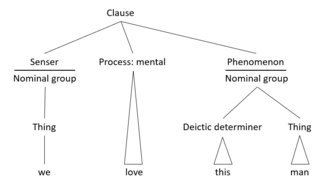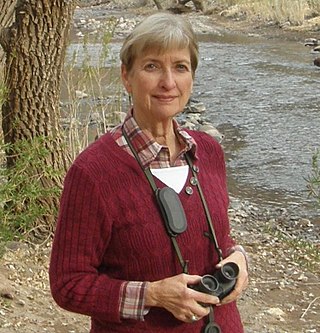
Functional linguistics is an approach to the study of language characterized by taking systematically into account the speaker's and the hearer's side,and the communicative needs of the speaker and of the given language community. Linguistic functionalism spawned in the 1920s to 1930s from Ferdinand de Saussure's systematic structuralist approach to language (1916).
The following outline is provided as an overview and topical guide to linguistics:
A lexeme is a unit of lexical meaning that underlies a set of words that are related through inflection. It is a basic abstract unit of meaning,a unit of morphological analysis in linguistics that roughly corresponds to a set of forms taken by a single root word. For example,in English,run,runs,ran and running are forms of the same lexeme,which can be represented as RUN.
A morpheme is the smallest meaningful constituent of a linguistic expression. The field of linguistic study dedicated to morphemes is called morphology.
In linguistics,morphology is the study of words,including the principles by which they are formed,and how they relate to one another within a language. Most approaches to morphology investigate the structure of words in terms of morphemes,which are the smallest units in a language with some independent meaning. Morphemes include roots that can exist as words by themselves,but also categories such as affixes that can only appear as part of a larger word. For example,in English the root catch and the suffix -ing are both morphemes;catch may appear as its own word,or it may be combined with -ing to form the new word catching. Morphology also analyzes how words behave as parts of speech,and how they may be inflected to express grammatical categories including number,tense,and aspect. Concepts such as productivity are concerned with how speakers create words in specific contexts,which evolves over the history of a language.
In linguistics,syntax is the study of how words and morphemes combine to form larger units such as phrases and sentences. Central concerns of syntax include word order,grammatical relations,hierarchical sentence structure (constituency),agreement,the nature of crosslinguistic variation,and the relationship between form and meaning (semantics). There are numerous approaches to syntax that differ in their central assumptions and goals.
In linguistics,transformational grammar (TG) or transformational-generative grammar (TGG) is part of the theory of generative grammar,especially of natural languages. It considers grammar to be a system of rules that generate exactly those combinations of words that form grammatical sentences in a given language and involves the use of defined operations to produce new sentences from existing ones.
Linguistics is the scientific study of human language. Someone who engages in this study is called a linguist. See also the Outline of linguistics,the List of phonetics topics,the List of linguists,and the List of cognitive science topics. Articles related to linguistics include:
Cognitive science is the scientific study either of mind or of intelligence . Practically every formal introduction to cognitive science stresses that it is a highly interdisciplinary research area in which psychology,neuroscience,linguistics,philosophy,computer science,anthropology,and biology are its principal specialized or applied branches. Therefore,we may distinguish cognitive studies of either human or animal brains,the mind and the brain.
Construction grammar is a family of theories within the field of cognitive linguistics which posit that constructions,or learned pairings of linguistic patterns with meanings,are the fundamental building blocks of human language. Constructions include words,morphemes,fixed expressions and idioms,and abstract grammatical rules such as the passive voice or the ditransitive. Any linguistic pattern is considered to be a construction as long as some aspect of its form or its meaning cannot be predicted from its component parts,or from other constructions that are recognized to exist. In construction grammar,every utterance is understood to be a combination of multiple different constructions,which together specify its precise meaning and form.
A mixed language,also referred to as a hybrid language,contact language,or fusion language,is a language that arises among a bilingual group combining aspects of two or more languages but not clearly deriving primarily from any single language. It differs from a creole or pidgin language in that,whereas creoles/pidgins arise where speakers of many languages acquire a common language,a mixed language typically arises in a population that is fluent in both of the source languages.
Principles and parameters is a framework within generative linguistics in which the syntax of a natural language is described in accordance with general principles and specific parameters that for particular languages are either turned on or off. For example,the position of heads in phrases is determined by a parameter. Whether a language is head-initial or head-final is regarded as a parameter which is either on or off for particular languages. Principles and parameters was largely formulated by the linguists Noam Chomsky and Howard Lasnik. Many linguists have worked within this framework,and for a period of time it was considered the dominant form of mainstream generative linguistics.
In linguistics and social sciences,markedness is the state of standing out as nontypical or divergent as opposed to regular or common. In a marked–unmarked relation,one term of an opposition is the broader,dominant one. The dominant default or minimum-effort form is known as unmarked;the other,secondary one is marked. In other words,markedness involves the characterization of a "normal" linguistic unit against one or more of its possible "irregular" forms.

Joan Lea Bybee is an American linguist and professor emerita at the University of New Mexico. Much of her work concerns grammaticalization,stochastics,modality,morphology,and phonology. Bybee is best known for proposing the theory of usage-based phonology and for her contributions to cognitive and historical linguistics.
Functional grammar (FG) and functional discourse grammar (FDG) are grammar models and theories motivated by functional theories of grammar. These theories explain how linguistic utterances are shaped,based on the goals and knowledge of natural language users. In doing so,it contrasts with Chomskyan transformational grammar. Functional discourse grammar has been developed as a successor to functional grammar,attempting to be more psychologically and pragmatically adequate than functional grammar.

In linguistic morphology,inflection is a process of word formation in which a word is modified to express different grammatical categories such as tense,case,voice,aspect,person,number,gender,mood,animacy,and definiteness. The inflection of verbs is called conjugation,and one can refer to the inflection of nouns,adjectives,adverbs,pronouns,determiners,participles,prepositions and postpositions,numerals,articles,etc.,as declension.
Linguistics is the scientific study of language. Linguistics is based on a theoretical as well as a descriptive study of language and is also interlinked with the applied fields of language studies and language learning,which entails the study of specific languages. Before the 20th century,linguistics evolved in conjunction with literary study and did not employ scientific methods. Modern-day linguistics is considered a science because it entails a comprehensive,systematic,objective,and precise analysis of all aspects of language –i.e.,the cognitive,the social,the cultural,the psychological,the environmental,the biological,the literary,the grammatical,the paleographical,and the structural.

Aspects of the Theory of Syntax is a book on linguistics written by American linguist Noam Chomsky,first published in 1965. In Aspects,Chomsky presented a deeper,more extensive reformulation of transformational generative grammar (TGG),a new kind of syntactic theory that he had introduced in the 1950s with the publication of his first book,Syntactic Structures. Aspects is widely considered to be the foundational document and a proper book-length articulation of Chomskyan theoretical framework of linguistics. It presented Chomsky's epistemological assumptions with a view to establishing linguistic theory-making as a formal discipline comparable to physical sciences,i.e. a domain of inquiry well-defined in its nature and scope. From a philosophical perspective,it directed mainstream linguistic research away from behaviorism,constructivism,empiricism and structuralism and towards mentalism,nativism,rationalism and generativism,respectively,taking as its main object of study the abstract,inner workings of the human mind related to language acquisition and production.
Jeroen van de Weijer is a Dutch linguist who teaches phonology,morphology,phonetics,psycholinguistics,historical linguistics and other courses at Shenzhen University,where he is Distinguished Professor of English linguistics at the School of Foreign Languages. Before,he was Full Professor of English Linguistics at Shanghai International Studies University,in the School of English Studies.
Integrational Linguistics (IL) is a general approach to linguistics that has been developed by the German linguist Hans-Heinrich Lieb and others since the late 1960s. The term "Integrational Linguistics" as a name for this approach has been used in publications since 1977 and antedates the use of the same term for integrationism,an unrelated approach developed by Roy Harris. Integrational Linguistics continues being developed by an open group of linguists from various countries.



